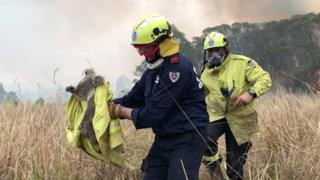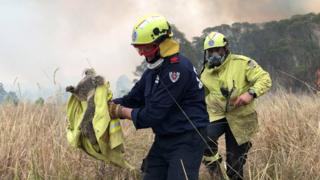Australia fires: How do we know how many animals have died?
A biodiversity expert suggests almost half a billion animals might have been affected in Australia. …

 Image copyright Reuters
Image copyright Reuters There is a widely-reported estimate that almost half a billion (480 million) animals have been killed by the bush fires in Australia.
It’s a figure that came from Prof Chris Dickman, an expert on Australian biodiversity at the University of Sydney.
He released a statement explaining how he had reached the figure – a statement which refers to the number of animals affected rather than those necessarily dying as a direct result of the fire (although the title of the release talks about 480 million being killed).
The numbers are based on a report he co-wrote in 2007 for the World Wide Fund for Nature (WWF) on the impact of land-clearing on Australian wildlife in New South Wales.
It estimated that there were an average of 17.5 mammals, 20.7 birds and 129.5 reptiles per hectare (10,000 square metres, so a square 100m on each side – about the size of a rugby pitch).
They’ve then multiplied that by the amount of land hit by the fires.
“We’ve estimated that in the three million hectares of New South Wales alone that were burned up until about 10 days ago probably as many as 480 million mammals, birds and reptiles would have been affected by the fires,” Prof Dickman said.
“Certainly, large animals, like kangaroos or emus – many birds, of course – will be able to move away from the fire as it approaches,” he told BBC Breakfast.
“I guess it’s the less mobile species and the smaller ones that depend on the forest itself that are really in the firing line.”
But he added that many of those that survived the actual fire would die later because of lack of food or shelter.
Colin Beale, an ecologist from University of York told Reality Check that may have been overstated.
He said: “In the areas of Africa where I work I am quite sure that very few birds die as a direct result of fire. They certainly have the ability to fly away from fires, and this is surely the case in Australia, too.”
There are a few caveats with these figures. First of all, the estimate is for damage only in New South Wales, and the fires have spread to Victoria.
Also, the three million hectares figure is somewhat out of date – the fires have spread since then. So it is likely that more animals have been affected than the estimate suggests.
But it is important to remember that this is just an estimate – its authors say the numbers are deliberately conservative. The figure for the number of reptiles is particularly uncertain, and reptiles make up three-quarters of the animals affected in these calculations.
“Density estimates are not available for many species, so they have had to be estimated from known densities of other species,” Tom Oliver, professor of applied ecology at University of Reading, told Reality Check.
“For reptiles, there are no density estimates of individual species at all, just an estimate from a single study (Ehmann and Cogger 1985), which estimates 10 individuals per species per hectare.”
Colin Beale added: “Although it is hard to find estimates of how well reptiles survive fires, in similar areas of Australia the majority of these reptiles live in the soil.”
“Soil is a very good thermal insulator and burrowing reptiles can certainly show very low mortality even during intense fires.”
“It seems extremely unlikely that the majority of the animals affected by fire are actually killed, though we may still ask whether they will survive longer-term.”
What claims do you want BBC Reality Check to investigate? Get in touch


